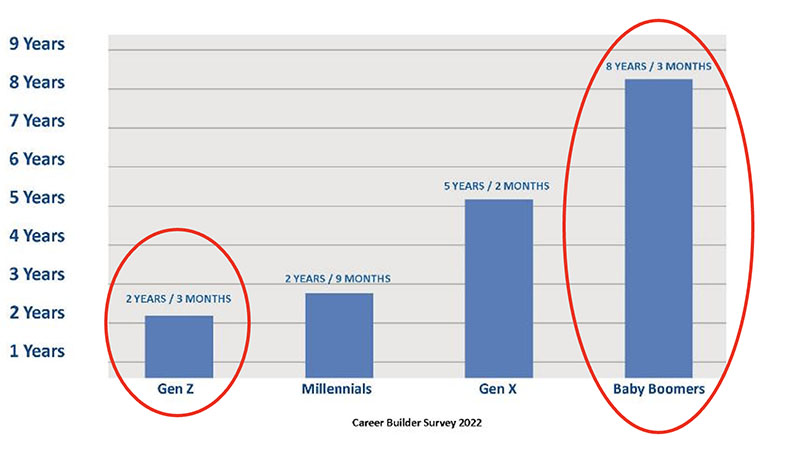Most hiring tools answer whether candidates can and will do the job, but not if they’ll stay. Learn how realistic job previews and motivational-fit interviews can improve retention from day one.
Which Generation Has Fastest-Growing Workforce?

You’ve read here before about the continuing workforce shortage due to large groups of baby boomers retiring with not enough young workers to replace them. Now we learn that we are in fact in a gem period, let’s call it a recruiting-opportunity open door, whereby some of the very best workers are in fact coming back to the workforce and are available to us.
New Numbers Are Just Part of the Emerging Workforce Story
The Wall Street Journal recently did a deep dive into the benefits of hiring older workers and here are some of their findings…all while considering that right now people 55 and older are the fastest-growing segment of our workforce according to federal data:[i]
- 75% of those 65 and older report that hard work is very important to them, whereby just 61% of those ages 18 to 29 said the same.
- Older workers are more likely to work for reasonable amounts of pay.
- And older workers aren’t looking for their next promotion.
How long will older workers continue to work? While some work for the money to supplement retirement savings, others work so they have something meaningful to do. We should leave past assumptions and biases behind us such as everyone quits at 65, and focus on meeting today’s need with who are the best available workers for the job.
And while numbers tell the baseline of this story, this quote from a KinderCare manager adds another perspective on real-life value of older workers:
“There’s a willingness from this group to work the opening shift or to close down for the day, to cover during lunches and breaks or even be on call as needed. I could go on and on about the value and benefits.”
The Generational Employee Retention What-If Question
Since this weekly report’s goal is to give you solutions to cut turnover, let’s pose a “what if” question using this interesting new data: After interviewing two candidates ages 22 and 62 who appear to be equally qualified, which candidate will stay longer?
What makes this question intriguing is we don’t know how long the 62-year-old intends to work…and age discrimination laws shield us from asking. But while sheer age indicates some ultimate end point for the 62-year-old’s working years, we can apply the three findings from above and conclude that those older workers will most likely prioritize their work, work for reasonable pay, and aren’t looking for “what’s next”.
I would also ask you to consider historical how-long-do-they-stay data, too, and these numbers should influence our thinking[ii]:
- Gen Z, 2 years 3 months.
- Millennials, 2 years 9 months (and currently the largest representation)
- Baby Boomers, 8 years 3 months

While we don’t have nearly the same amount of workforce data on Gen Z as the others, we probably know even less about our 22-year-old candidate’s commitment to work, contentment with pay, or desire to move up or an urge to relocate to Portugal six months from now…as opposed to what we know about our 62-year-old candidate.
Retention is More About Our Work Cultures, Not Age or Pay
Either way, which one stays longer is more about us than about them. After all, we are talking employee retention and every leave counts no matter the age. Consider these two findings that are reinforced everyday by our clients’ transitions from high turnover to improving their employee retention by 20% and more:
Finding #1: The primary reason employees stay or leave is how much they trust their direct supervisors. So your supervisors are your very best retention tool, way more important than pay, benefits, or any other of the HR-driven tangibles that are believed to matter more.
Finding #2: The greatest frustrations employees say out loud during Stay Interviews are about day-to-day work, things like poor-performing colleagues, ineffective equipment, or reports that go nowhere.
MIT’s recently-released study tells us that the top reason employees quit during “The Great Resignation” is what they called Toxic Corporate Culture. They defined Toxic Corporate Culture as (1) failure to promote diversity, equity, and inclusion, (2) workers feeling disrespected, and (3) unethical behavior…and go on to say these leave reasons are ten times more prevalent and more important than pay.[iii]
Gallup’s most recent work regarding employees’ quitting says 47% of those who leave do so because of Engagement and Culture, whereas just 14% have left for pay. Gallup’s definition of Engagement and Culture includes (1) lack of respect, (2) advancement & development opportunities, and (3) unrealistic job expectations.[iv]
Connecting the Data Dots on Retention
MIT’s top leave reasons are (1) failure to promote diversity, equity, and inclusion, (2) workers feeling disrespected, and (3) unethical behavior.
Gallup’s top leave reasons are (1) lack of respect, (2) advancement & development opportunities, and (3) unrealistic job expectations.
Each of the six leave reasons mentioned above starts at the first-line supervisor level, all of which points directly to what I referred to as the #1 finding from both academic research and from our clients, that the primary reason employees stay or leave is how much they trust their direct supervisors.
This same principal applies to employees of all ages whether 22 or 62. So while we don’t know when we hire someone how committed they are to the work, how content they are with pay, or if they are already seeking their next job, we have learned that the absolutely best way to help supervisors build trust with them from the start is by conducting Stay Interviews. That when supervisors learn to listen, probe, take note, and build individualized stay plans for each employee, they build the trust that cuts turnover by 20% and more…and often times much, much more.
Does your C-Suite need a wakeup call on how much turnover is actually costing you? Turnover is not an HR problem, it’s a leadership problem at each leadership level from the bottom up.
Schedule a conversation with me at DFinnegan@C-SuiteAnalytics.com to discuss your turnover challenges and I’ll share how you can use dollars instead of percentages to deliver your C-Suite team a wakeup call! Or I’ll do it for you as we’ve proven in every industry that you can cut turnover by 20% and more.
[i] https://www.wsj.com/articles/do-older-workers-work-harder-some-bosses-think-so-c4088c7d
[ii] https://www.forbes.com/sites/lucianapaulise/2021/10/26/why-millennials-and-gen-z-are-leading-the-great-resignation-trend/?sh=169b6f3444fe
[iii] https://sloanreview.mit.edu/article/toxic-culture-is-driving-the-great-resignation/
[iv] From Gallup’s new book Culture Shock, by Clifton and Harter, published by Gallup Press, 2023, page 68.



